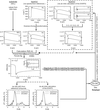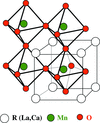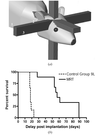issue contents
July 2009 issue

Cover illustration: Tomographic reconstruction of the anatomy of a rat brain, obtained with X-ray grating interferometry at the TOMCAT beamline of the Swiss Light Source at Paul Scherrer Institut, Villigen, Swizerland (see McDonald, Marone, Hintermüller, Mikuljan, David, Pfeiffer and Stampanoni, pages 562-572). With a sensitivity of the order of 1 mg cm-3 at an isotropic voxel size of 7.4 µm, this method allows brain regions such as hippocampus and cerebellum (with white and grey matter) to be visualized with a contrast impossible to reach for conventional absorption-based imaging.
facility information
research papers
The influence of surface and interface roughness on grazing-incidence reflection-mode EXAFS spectra is evaluated in detail. An oxidized Cu thin film sample is discussed as an example.
Natural circular dichroism spectra in the extreme vacuum ultraviolet region down to a wavelength of 80 nm are observed for the first time using a polarizing undulator-based circular dichroism system.
The Pixium 4700 flat-panel detector has been characterized for use in high-energy X-ray diffraction experiments.
A multiple-analyser-crystal spectrometer for non-resonant inelastic X-ray scattering spectroscopy at beamline ID16 of the European Synchrotron Radiation Facility is presented.
A 15 Gy/79 keV focal synchrotron irradiation elicits no short-term modifications of the blood-brain-barrier permeability, vascular parameters and no apparition of gliosis in healthy mouse brain tissue.
An in situ photochemical endstation for soft X-ray spectroscopy has been developed to allow for direct monitoring of photochemical processes using X-ray absorption spectroscopy.
The radiation tolerance of a single-photon-counting hybrid pixel detector has been studied. An indicative exposure time required for radiation-induced departure from nominal behaviour is quoted in conjunction with compensation techniques.
EXAFS studies of the local structure of as-grown and capped InGaN/GaN quantum dots.
A new small-angle X-ray scattering set-up has been designed and constructed on a crystallography beamline at MAX-lab.
The optical design of the soft X-ray beamline for transmission X-ray microscopy at the ALBA Light Source is presented.
A new portable multi-anvil device for in situ angle-dispersive synchrotron diffraction studies at pressures up to 25 GPa and temperatures up to 2000 K is described.
A radiation furnace that covers the temperature range from room temperature up to 1800 K designed and constructed for in situ synchrotron microtomography is introduced. The furnace operates under a vacuum or under any inert gas atmosphere and achieves very fast heating and cooling rates.
Components of secondary fly ashes, collected separately by heating municipal solid waste incinerators fly ashes at different high temperatures, have been characterized by different techniques. The chemical forms of zinc were investigated and compared in these fly ashes by means of X-ray absorption spectroscopy.
A critical re-examination of the Mn K-edge XANES edge-shift analyses in the intermediate La1−xCaxMnO3 compounds is presented based in ab initio multiple-scattering computations.
Functional groups, such as ketone (C=O) and amino (NH2), of DNA base guanine are removed one by one to give model molecules of hypoxanthine, 2-aminopurine and unsubstituted purine. The impact of the functional groups on the electronic properties, such as Hirshfeld charges, condensed Fukui functions and inner-shell ionization spectra, of the model molecules are studied and compared.
This study utilized synchrotron phase-contrast X-ray imaging (PCXI) to examine the in vitro detectability of a range of commonly inhaled particulates of which asbestos, fibreglass, quarry dust and the lead-containing mineral galena were found to be visible. These were then instilled into the airways of live anaesthetized mice, and their behaviour on the airway surface was analysed using PCXI.
A grating-based differential phase-contrast (DPC) instrument has been fully integrated into the TOMCAT endstation environment of the Swiss Light Source, both in terms of fast acquisition and reconstruction. A range of imaging techniques are illustrated, from region-of-interest and widefield DPC tomography to darkfield imaging.
Intracerebral delivery of IUdR in combination with synchrotron radiation therapy.
A new method of creating minibeam patterns for synchrotron radiation therapy is presented. The success of the feasibility study of this method performed at the biomedical beamline at the European Synchrotron Radiation Facility opens the door to new medical research in minibeam radiation therapy.
short communications
Microbeam radiation therapy with synchrotron radiation for treating brain gliomas: temporal fractionation study of the delivered therapeutic dose.
computer programs
Differential EXAFS is a new XAS technique dedicated to directly measuring the tiny atomic displacements that arise from such strain-inducing phenomena as magnetostriction, piezoelectricity and thermal expansion. These new experiments have presented the need for new analysis tools to extract and quantify the measured atomic strains, a need that has been addressed by the development of the DEXA code.
laboratory notes
A video camera system for observing a sample from the direction of an incident soft X-ray beam has been developed for efficient positioning of samples in the beam position.
current events
Free 



 journal menu
journal menu
















































